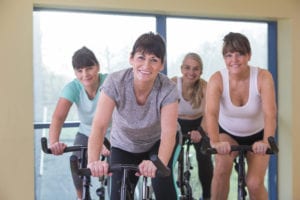Written by Chrystal Moulton, Staff Writer. Active individuals had a lower BMI, waist circumference, VO2 threshold, VO2 peak, age predicted VO2, and metabolic equivalent peak compared to their inactive counterparts.
 Physical activity is essential to overall health and well-being. In a recent study, researchers showed that physical activity can significantly improve lipid profile1,2. In another study testing cholesterol transfer, researchers found physically active individuals had increased cholesterol to HDL transfer rates compared to their inactive individuals2,3. In each of the previous studies, physical activity was beneficial to achieving improvement in the lipid profile. In the current trial, researchers investigated cholesterol transfer to HDL in both old and young, male, and female participants4.
Physical activity is essential to overall health and well-being. In a recent study, researchers showed that physical activity can significantly improve lipid profile1,2. In another study testing cholesterol transfer, researchers found physically active individuals had increased cholesterol to HDL transfer rates compared to their inactive individuals2,3. In each of the previous studies, physical activity was beneficial to achieving improvement in the lipid profile. In the current trial, researchers investigated cholesterol transfer to HDL in both old and young, male, and female participants4.
Participants between the age of 20- 35 years old as well as those over 60 years old both male and female were recruited for this investigation. Participants were asked their level of physical activity and whether they participated in an exercise training program in the past 12 months. Volunteers were, then, divided into four groups based on their answers. A treadmill exercise test was conducted to determine VO2 Peak, VO2 threshold, and absolute VO2. Researchers also calculated the oxygen uptake efficiency slope (OUES), metabolic equivalent of peak VO2 (MET), and age predicted VO2 based on gender. Dietary habits were not included as part of this trial. Blood samples were collected from each volunteer after 12 hour overnight fast. Samples were used to measure HDL, LDL, total cholesterol, cholesterol ester transfer protein (CETP), lecithin cholesterol acyltransferase (LCAT), and paraoxonase-1 activity (PON1). The samples are also used to test cholesterol transfer activity.
The total number of participants was 108 who were divided into four groups: active young (n= 39), inactive young (n = 24), active older (n = 24), and inactive older (n = 21). Active individuals had a lower BMI, VO2 threshold, VO2 peak, age predicted VO2, and metabolic equivalent peak compared to their inactive counterparts. Also, HDL-C and the transfer of unesterified cholesterol to HDL was higher in active individuals compared to their inactive counterparts. (See Table 1 and 2) No statistically significant results were observed for PON1 activity.
Table 1. Results for Active/Inactive Older Adults
| Active Older Adults (n=24) | Inactive Older Adults (n=21) | P-value | |
| BMI (kg/m2) | 24.7 ± 2.7 | 28.1 ± 4.8 | P< 0.01 |
| VO2 Peak (mL/kg/min) | 32.6 ± 5.2 | 27.3 ± 5.9 | P< 0.05 |
| VO2 Threshold (mL/kg/min) | 22.6 ± 3.0 | 18.4 ± 3.7 | P< 0.05 |
| Age-predicted VO2 (mL/kg/min) | 119 | 102 | P< 0.05 |
| HDL | 67 ± 14 | 51 ± 14 | P< 0.01 |
| MET | 9.3 ± 1.5 | 7.8 ± 1.7 | P< 0.05 |
| Cholesterol to HDL (esterified) | 4.71 | 4.20 | Non-significant |
| Cholesterol to HDL (unesterified) | 6.43 | 5.45 | P< 0.01 |
Table 2. Results for Active/Inactive Young Adults
| Active Young Adults (n=39) | Inactive Young Adults (n=24) | P-value | |
| BMI (kg/m2) | 24.2 ± 2.4 | 23.5 ± 3.5 | Non-significant |
| VO2 Peak (mL/kg/min) | 46.4 ± 4.9 | 37.5 ± 7.6 | P< 0.001 |
| VO2 Threshold (mL/kg/min) | 32.1 ± 6.6 | 23.0 ± 4.7 | P< 0.001 |
| Age-predicted VO2 (mL/kg/min) | 109 | 88 | P< 0.001 |
| HDL | 62 ± 15 | 49 ± 14 | P< 0.001 |
| MET | 13.4 ± 1.6 | 10.5 ± 1.7 | P< 0.001 |
| Cholesterol to HDL (esterified) | 4.23 | 3.83 | P< 0.05 |
| Cholesterol to HDL (unesterified) | 5.98 | 5.32 | P< 0.05 |
Overall, results from this investigation showed that physical activity significantly increased cholesterol transfer to HDL and improved lipid profile in both young and older adults. Additional studies will be needed to verify these findings.
Source: Braga, Pedro GS, Fatima R. Freitas, André LL Bachi, Gislene R. Amirato, Roberta V. Baroni, Maria Janieire NN Alves, Rodolfo P. Vieira et al. “Regular Practice of Physical Activity Improves Cholesterol Transfers to High-Density Lipoprotein (HDL) and Other HDL Metabolic Parameters in Older Adults.” Nutrients 15, no. 23 (2023): 4871.
© 2023 by the authors. Licensee MDPI, Basel, Switzerland. This article is an open access article distributed under the terms and conditions of the Creative Commons Attribution (CC BY) license (https://creativecommons.org/licenses/by/4.0/).
Click here to read the full text study.
Posted December 12, 2023.
Chrystal Moulton BA, PMP, is a 2008 graduate of the University of Illinois at Chicago. She graduated with a bachelor’s in psychology with a focus on premedical studies and is a licensed project manager. She currently resides in Indianapolis, IN.
References:
- Bachi AL, Rocha GA, Sprandel MC, et al. Exercise Training Improves Plasma Lipid and Inflammatory Profiles and Increases Cholesterol Transfer to High-Density Lipoprotein in Elderly Women. J Am Geriatr Soc. Jun 2015;63(6):1247-9. doi:10.1111/jgs.13500
- Bull FC, Al-Ansari SS, Biddle S, et al. World Health Organization 2020 guidelines on physical activity and sedentary behaviour. Br J Sports Med. Dec 2020;54(24):1451-1462. doi:10.1136/bjsports-2020-102955
- Casella-Filho A, Chagas AC, Maranhão RC, et al. Effect of exercise training on plasma levels and functional properties of high-density lipoprotein cholesterol in the metabolic syndrome. Am J Cardiol. Apr 15 2011;107(8):1168-72. doi:10.1016/j.amjcard.2010.12.014
- Braga PG, Freitas FR, Bachi AL, et al. Regular Practice of Physical Activity Improves Cholesterol Transfers to High-Density Lipoprotein (HDL) and Other HDL Metabolic Parameters in Older Adults. Nutrients. 2023;15(23):4871.
